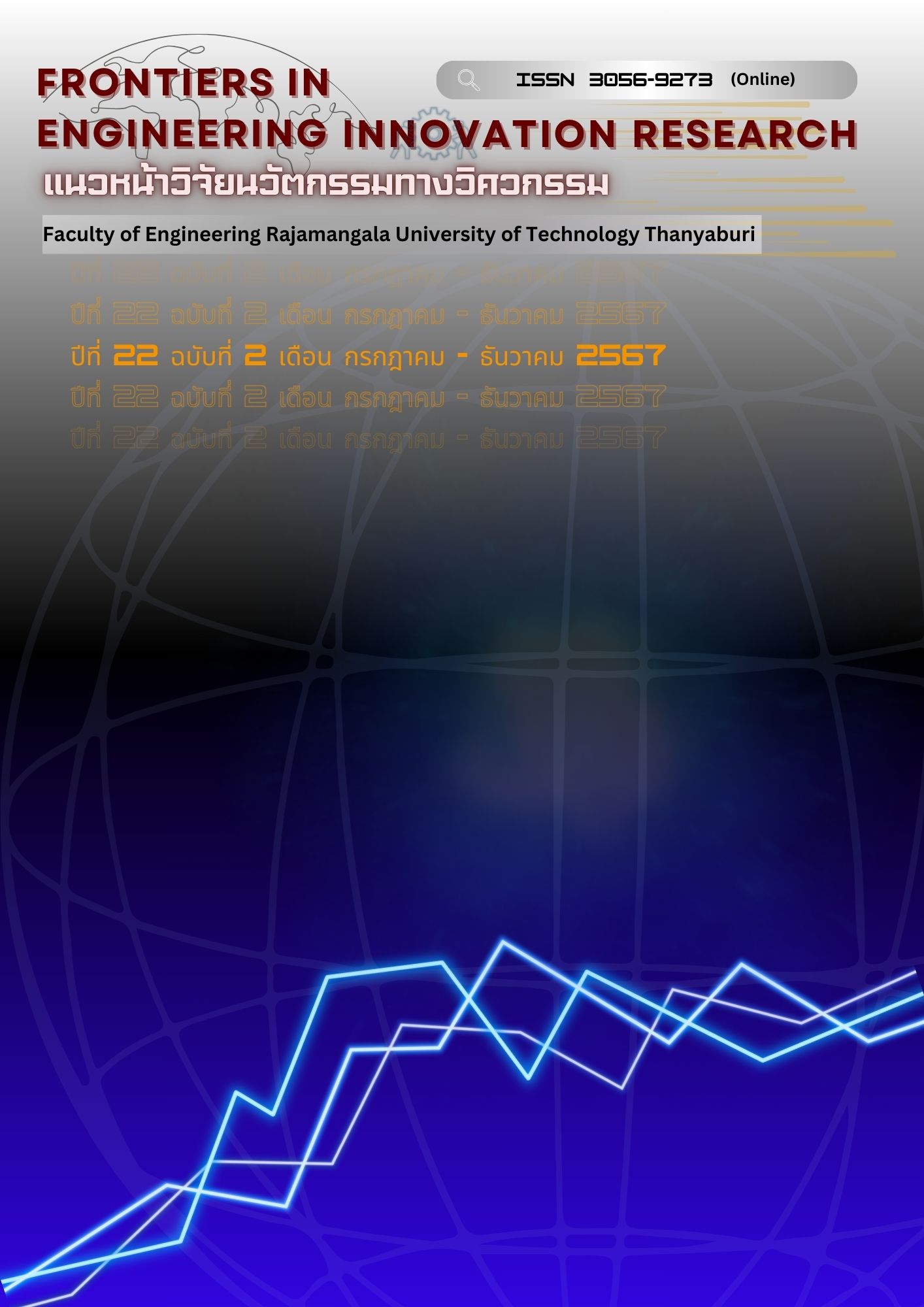Flue gas control parameter effects of biomass carbonization with heating coil on the production of lotus charcoal for odor absorption
Main Article Content
Abstract
This research aimed to study the effects of flue gas control parameters including flue gas temperature and flue gas velocity of biomass carbonization with heating coil on the production of lotus charcoal for odor adsorption. The odor absorbing charcoal machine had a drying chamber of 50 × 45 × 35 cm3 which could contain 6 pods. Hot smoke was generated from a 100 liter kiln. Next, the hot smoke was increased temperature by using a heater before entering the drying chamber. At the kiln, a fan was installed for blowing the air to the kiln. The fan could control the speed for adjusting the air to the kiln. Experiment, the lotus had an initial moisture content of 86.19±1.67 % wet basis and was dried to the final moisture content of 0 % wet basis. The control variables were smoke temperatures of 200, 250 and 300°C and smoke velocities of 1.22, 1.74 and 2.27 m/s. It was found that at flue gas temperatures of 200, 250 and 300˚C, the production time for odor absorber was 120, 100 and 60 min, respectively, but at constant flue gas temperature and increasing flue gas velocity, the production time for odor absorber was the same because the raw materials did not come into direct contact with the flue gas. The raw materials were packed in another layer of the raw material cabinet to prevent the lotus from burning and turning into ash so the exhaust gas touched the outer wall surface of the raw material cabinet. Therefore, the drying method was a heat radiation drying method and the drying result was to depend on only one temperature variable. An iodine adsorption and a specific energy consumption were studied. It was found that increasing the temperatures and the velocities of hot smoke, the iodine adsorption and the specific energy consumption were increased. At 300˚C with the flue gas velocity 2.27 m/s had the maximum iodine adsorption value of 1176.32±21.562 mg/g.
Article Details

This work is licensed under a Creative Commons Attribution-NonCommercial-NoDerivatives 4.0 International License.
The manuscript, information, content, picture and so forth which were published on Frontiers in engineering innovation research has been a copyright of this journal only. There is not allow anyone or any organize to duplicate all content or some document for unethical publication.
References
Mai Ngam Subdistrict Municipality. Nong Bua Public Park of Nong Luang. [Internet]. [28 November 2024]; Available from: Online,. https://www.maingam.go.th/trv-otp-detail?page=4&id=730 (In Thai)
Boonyang K. Developing grassroot economy by creating value of royal lotus of communities in Yokkrabat Subdistrict, Samngao District, Tak Province. Academy Journal of Northern. 2023;10(2):27-43.
Pianjing P, Punyakham P, Prapreud W, Kitprathaung N, Phromsat Ph, Wites J. Development of odor absorbed charcoal lump product from nipa palm fruit. Phranakhon Rajabhat Research Journal (Science and Technology). 2023;18(2):14-29. (In Thai)
Kengkhetwit C. Investigation of the effect of burning temperature range on physical changes and iodine value in mangosteen odor adsorbing charcoal. [master's thesis]. Bangkok: Mahanakorn University of Technology; 2014. (In Thai)
Sinsaard A. Development of activated charcoal from a coconut shell kiln. Industrial Technology Lampang Rajabhat University Journal. 2017;10(2)95-108. (In Thai)
Li Q, Liu S, Wang L, Chen F, Shao J, Hu X. Efficient nitrogen doped porous carbonaceous CO2 adsorbents based on lotus leaf. Journal of Environmental Sciences. 2021;103:268-78.
Thai Industrial Standards Institute. Community Product Standard for Odor-Absorbing Charcoal (M P Ch. 180/2003) [Internet]. 2013 [24 July 2024]; Available from: https://www.charcoal.snmcenter.com/charcoalthai/standard1.php (In Thai)
Buaklee A. Design and fabrication of lotus leaves cutting machine. [master's thesis]. Pathum Thani: Rajamangala University of Technology Thanyaburi; 2018. (In Thai)
Rattanapan S, Pengchaem P, Kongsun P. Preparation and caracterization of mangosteen peel activated carbon. ASEAN Journal of Scientific and Technological Reports (AJSTR). 2014;17(3):13-21. (In Thai)
Chunkaew P, Tavata A, Khadwilard A, Sriudom Y. Bananas drying performance with a developed hot air dryer using waste heat from charcoal production process. RMUTP Research Journal. 2018;12(1):147-58. (In Thai)
Chunkaew P, Khadwilard A, Thawonngamyingsakul C. Drying bananas with a modified hot air dryer using waste heat from a 200 liter kiln. Research on Modern science and Utilizing Technological Innovation Journal (RMUTI Journal). 2017;10(3):1-12.
Congpupa P, Tapie O, Saadchom P. Effect of drying temperatures on charcoal briquettes drying using a combined solar energy and far-infrared radiation dryer, and a far-infrared radiation dryer. RMUTP Research Journal Sciences and Technology. 2016;10(1):77-93. (In Thai)
Niamsewak P. Comparison of adsorption capacity of activated carbon obtained from different production methods and materials. Science and Technology Nakhon Sawan Rajabhat University Journal. 2010;2(2):11-18. (In Thai)
Somsila P, Buntham E, Homjumpa T. Development of a dryer using biomass as fuel. PSRU Journal of Industrial Technology and Engineering. 2022;4(1):107-24.
Yoomee P. Preparation of high surface area activated charcoal from wood charcoal powder using a dry chemical activation process. KKU Science Journal. 2015;43(4):788-98.


